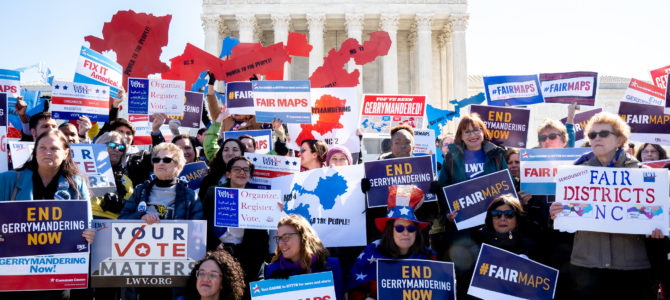
The leftist push for “voting reform” bills purportedly includes an end to partisan district drawing. But Democrats’ plans for New York and Oregon show they are part of the problem, not the solution.
One of the key talking points for Democrats’ push for voting “reform” is a desire to end what they call the pernicious practice of partisan gerrymandering. It’s been part of each of their so-far-failed legislative attempts to transform voting in the United States that go under various names, like the “For the People Act” and the act named after Georgia congressman and civil rights leader John Lewis.
That their proposed “reforms” seem more focused on questioning the integrity of the vote than in expanding the franchise is not lost on Republicans. But as much as an end to mythical “voter suppression” is the chief goal of the Democrats’ efforts, they are particularly interested in ending gerrymandering, which left-wingers claim is the main reason the GOP is able to compete for control of the U.S. House of Representatives.
Gerrymandering Is As Old As the Republic
Democrats dominated the House of Representatives throughout most of the 20th century. They won the House when several Republican members died shortly after the 1930 election, and lost control of it for only two brief two-year periods (1947-49 and 1953-55) over the course of six decades before being swept aside in 1994 in Newt Gingrich’s Contract With America landslide. During that long period of power, they used their majorities to legislate a vast expansion of government bureaucracy and entitlements.
The House changed hands in 2006, 2010, and 2018 and most pundits assume that the usual backlash against the party in power, aided by President Joe Biden’s disastrous performance, will lead to another changeover in 2022. But to Democrats, what ought to be a normal thing in a democracy — parties winning and losing power based on their ideas and performance in office — is nothing but the result of dirty political tricks by their opponents. They claim GOP competitiveness is rooted in gerrymanders, not the will of the people.
Gerrymanders are almost as old as the republic and have long been considered unsavory but legal. As recently as 2019, the U.S. Supreme Court reaffirmed in Rucho v. Common Cause that gerrymanders are a political question and beyond the scope of the courts to prohibit. But that hasn’t stopped Democrats from complaining that Republicans are rigging the system.
How the Voting Rights Act Helped Republicans
Part of the problem is demographics. Democrats tend to clump together on the coasts and big cities, while Republicans are more evenly spread out throughout the country. That disparity creates districts in blue states where only one party — the Democrats — competes. While there are some similarly lopsided districts in red states, they are vastly outnumbered by the constituencies Democrats dominate.
Still, that leaves plenty of room for partisan hijinks in which parties use state legislative majorities to draw districts that help their side while hurting opponents. In recent decades, that has been aided by computer analyses that allowed those drawing the districts to micromanage the process even more effectively.
Gerrymandering was never seen as decisive until the 1990s when the Democrats’ monopoly on the House was finally upended. But the reason for that was not that the GOP had invented newer and better ways to rig the system. Rather, it was caused by something Democrats insist is sacred: the Voting Rights Act of 1965.
It was not until the late 1980s that the landmark legislation that ended de jure disenfranchisement and the legacy of Jim Crow was interpreted as mandating the creation of majority-minority districts. These districts with at least approximately 50 percent minority voters were designed to ensure that African Americans and Hispanics would be able to elect members of their races to Congress. But while this allowed historically underrepresented groups to be present in the halls of power, it had a devastating impact on Democrats.
A system that herds minority voters into such districts had the effect of draining hitherto competitive districts of the Democrats’ most reliable demographic voting groups. The districts created by this process were the epitome of what gerrymandered districts have always looked like; they disregarded traditional geographic boundaries and looked absurd on the map.
No better example of such a misshapen district exists than South Carolina’s 6th district, home to 81-year-old House Majority Whip Rep. James Clyburn, who has held the seat since 1993. Were the state’s voters more evenly distributed in a map that made conventional sense, Clyburn’s routine two-thirds majority would evaporate, but it might make the Democrats more competitive in other districts. As the leftist magazine The Atlantic has noted, such configurations have been a huge advantage for Republicans throughout the country.
Democrats prefer to ignore that their real problem isn’t with GOP district-drawing masterminds but with the Voting Rights Act they cherish and the minority political bosses like Clyburn that they dare not challenge. Meanwhile, they’re planning on some of the most blatantly hypocritical gerrymandering schemes in what they hope will save their majority.
Democrats Plan Gerrymandering in New York, Oregon
As The New York Times reported, New York Democrats are planning to employ their super-majorities in that state’s legislature to override a bipartisan districting commission to take out as many as five of the seven Republicans who currently represent the state in Congress. Redistricting is necessary because New York, due to its declining population, is one of seven states to lose seats in the House.
It would be expected that the lost seat would come from the party that doesn’t control the legislature, but Democrats are planning for a scheme that would skim GOP voters out of every district where they predominate to give the Democrats chances to win seats on Eastern Long Island, upstate New York, and deep-red Staten Island (the only one of New York City’s boroughs that isn’t deep blue). As they do this, U.S. Senate Majority Leader Charles Schumer of New York rails against Republicans for gerrymandering.
They’re planning on doing the same thing in Oregon, which stands to gain a seat next year. Oregon Democrats are trying to split up deep-blue Portland and channel its voters into three districts that stretch down the Pacific Coast and east across the Cascade Mountains. If approved, it would lock up five of the state’s six seats for the Democrats for the next decade.
So while Schumer is carrying on about Republicans in Texas and Florida (which will each get another seat) using their power to ensure they gain seats next year, the notion that gerrymandering is inherently a Democrat or Republican weapon and therefore a threat to democracy is nonsense. There is no way to take politics out of a necessary process for redrawing districts. While nothing for either side to boast about, Democrats’ bleating about the practice as a plot to harm them is nothing but hypocritical nonsense.







